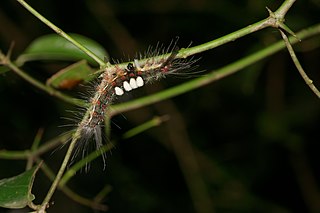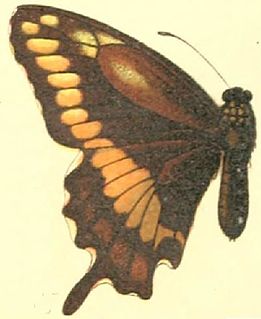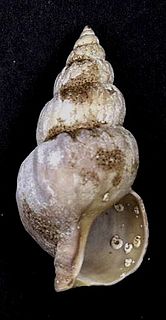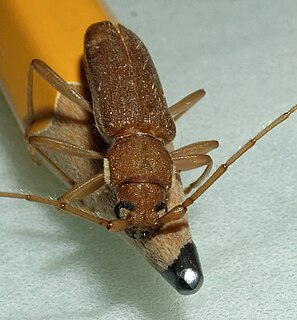A genus is a taxonomic rank used in the biological classification of living and fossil organisms, as well as viruses, in biology. In the hierarchy of biological classification, genus comes above species and below family. In binomial nomenclature, the genus name forms the first part of the binomial species name for each species within the genus.
The International Code of Zoological Nomenclature (ICZN) is a widely accepted convention in zoology that rules the formal scientific naming of organisms treated as animals. It is also informally known as the ICZN Code, for its publisher, the International Commission on Zoological Nomenclature. The rules principally regulate:
The International Code of Phylogenetic Nomenclature, known as the PhyloCode for short, is a formal set of rules governing phylogenetic nomenclature. Its current version is specifically designed to regulate the naming of clades, leaving the governance of species names up to the rank-based nomenclature codes.

The Lymantriinae are a subfamily of moths of the family Erebidae. The taxon was erected by George Hampson in 1893.
In botany, an infraspecific name is the scientific name for any taxon below the rank of species, i.e. an infraspecific taxon. The scientific names of botanical taxa are regulated by the International Code of Nomenclature for algae, fungi, and plants (ICN). This specifies a 'three part name' for infraspecific taxa, plus a 'connecting term' to indicate the rank of the name. An example of such a name is Astrophytum myriostigma subvar. glabrum, the name of a subvariety of the species Astrophytum myriostigma.
In botanical nomenclature, author citation is the way of citing the person or group of people who validly published a botanical name, i.e. who first published the name while fulfilling the formal requirements as specified by the International Code of Nomenclature for algae, fungi, and plants (ICN). In cases where a species is no longer in its original generic placement, both the authority for the original genus placement and that for the new combination are given.
In zoological nomenclature, the valid name of a taxon is the sole correct scientific name. The valid name should be used for that taxon, instead of any other name that may currently be being used, or may previously have been used. A name is valid when, and only when, it is in harmony with all the relevant rules listed in the International Code of Zoological Nomenclature (ICZN). A valid name is the correct zoological name of a taxon.
In biology, a homonym is a name for a taxon that is identical in spelling to another such name, that belongs to a different taxon.
A conserved name or nomen conservandum is a scientific name that has specific nomenclatural protection. That is, the name is retained, even though it violates one or more rules which would otherwise prevent it from being legitimate. Nomen conservandum is a Latin term, meaning "a name to be conserved". The terms are often used interchangeably, such as by the International Code of Nomenclature for Algae, Fungi, and Plants (ICN), while the International Code of Zoological Nomenclature favours the term "conserved name".

The Terebridae, commonly referred to as auger shells or auger snails, is a group or family of small to large predatory marine gastropods in the superfamily Conoidea.
In biological nomenclature, a nomen novum, new replacement name is a technical term. It indicates a scientific name that is created specifically to replace another scientific name, but only when this other name cannot be used for technical, nomenclatural reasons ; it does not apply when a name is changed for taxonomic reasons. It is frequently abbreviated, e.g.nomen nov., nom. nov..
The Botanical and Zoological Codes of nomenclature treat the concept of synonymy differently. In botanical nomenclature, a synonym is a scientific name that applies to a taxon that (now) goes by a different scientific name. For example, Linnaeus was the first to give a scientific name to the Norway spruce, which he called Pinus abies. This name is no longer in use: it is now a synonym of the current scientific name, Picea abies. In zoology, moving a species from one genus to another results in a different binomen, but the name is considered an alternative combination, rather than a synonym. The concept of synonymy in zoology is reserved for two names at the same rank that refer to a taxon at that rank - for example, the name Papilio prorsaLinnaeus, 1758 is a junior synonym of Papilio levanaLinnaeus, 1758, being names for different seasonal forms of the species now referred to as Araschnia levana(Linnaeus, 1758), the map butterfly. However, Araschnia levana is not a synonym of Papilio levana in the taxonomic sense employed by the Zoological code.

Battus zetides, the zetides swallowtail, is a species of butterfly in the family Papilionidae. It is found in Haiti and the Dominican Republic.

Ithomiini is a butterfly tribe in the nymphalid subfamily Danainae. It is sometimes referred to as the tribe of clearwing butterflies or glasswing butterflies. Some authors consider the group to be a subfamily (Ithomiinae). These butterflies are exclusively Neotropical, found in humid forests from sea level to 3000 m, from Mexico to Argentina. There are around 370 species in some 40–45 genera.

Buccinum scalariforme, common name the silky buccinum, is a species of sea snail, a marine gastropod mollusk in the family Buccinidae, the true whelks.
This is a list of terms and symbols used in scientific names for organisms, and in describing the names. For proper parts of the names themselves, see List of Latin and Greek words commonly used in systematic names. Note that many of the abbreviations are used with or without a stop.

Stromatium fulvum is a species of beetle in the family Cerambycidae. It was first described by Charles Joseph Devillers in 1789, and while his name was preoccupied, it is treated as valid following ICZN Article 23.9.5; it has most commonly been referred to as Stromatium unicolor, and more recently as Stromatium auratum but these names are junior synonyms.
Mimonephelotes enganensis is a species of beetle in the family Cerambycidae, and the only species in the genus Mimonephelotes. It was described by Breuning in 1970. Breuning mistakenly thought the name was a junior homonym of the genus Mimonephelotus and proposed a replacement name, Mimanhammus in 1971, but under the ICZN the two names are not homonyms, so the original genus name is valid.
Deliathis neonivea is a species of beetle in the family Cerambycidae. It was described by Stephan von Breuning in 1943, but the original name is a junior homonym of Deliathis nivea so its name was replaced in 2018. It is known from Mexico.

Pycanum rubens is a species of giant stink bug in the family Tessaratomidae. The species is widespread, and has been recorded in Borneo, Burma, China (Yunnan), India (Hindustan), Indonesia, Java, the Malay Peninsula, Moluccas, Philippines, Sumatra, and Vietnam.







